Subject: Wyoming and Montana Travelogue
Last September, I managed to visitGrand Teton, andYellowstoneNational Parks, camp and hike inGlacierNational Park, and visit Little Big Horn National Monument all in one trip. Over the course of seven days, my friends and I drove over2,000 miles, hiked over25 miles, saw waterfalls, glaciers, geysers, peaks and lakes of incredible beauty, and marveled at bison, elk, big horn sheep and mountain goats. It all started the day after Labor Day.
I flew out of Reagan National (DCA), and changed planes in Detroiton the way to Denver. The flight from DCA to Detroitwas only about half full, so the empty seats made even the old war horse DC-9 (an MD-90) we flew feel comfortable. It was the first (and only) non-full flight I took that summer. We were a few minutes late arriving, and I had to run from gate A23 to gate A74 where my flight to Denverwas taking off in 20 minutes. The Delta (former Northwest) concourse at Detroitis huge! The plane (an A320) was full, so they checked my bag at the gate. I arrived at Denverabout 20 minutes early, and my friend Bob met me as I was wandering around the baggage area. And then we were heading off on I-25 to Wyoming.  We entered Wyoming (first time in my life) and then at Cheyenne started west on I-80. The Wyoming Welcome Center on I-80 is west of Cheyenne, and we stopped there to get highway maps and eat lunch. There is a Lincoln Highway memorial at this stop (you can see the location of the old highway (US 30) on a hill to the south of the monument), as well as exhibits on Wyoming places of note. Did you know that Sacagawea is buried in Wyoming? There are many famous buttes in the state, and of course, Wyoming is the home of Grand Teton National Park and Yellowstone National Park, which we would visit the next day.
We entered Wyoming (first time in my life) and then at Cheyenne started west on I-80. The Wyoming Welcome Center on I-80 is west of Cheyenne, and we stopped there to get highway maps and eat lunch. There is a Lincoln Highway memorial at this stop (you can see the location of the old highway (US 30) on a hill to the south of the monument), as well as exhibits on Wyoming places of note. Did you know that Sacagawea is buried in Wyoming? There are many famous buttes in the state, and of course, Wyoming is the home of Grand Teton National Park and Yellowstone National Park, which we would visit the next day.
Off of the Interstate and on to US 287, we drove until about 7:30 pm when we reached Lander, WY. Several chain motels, two supermarkets and three auto dealerships indicate that Lander is a commercial center of some sort. We stayed at the Downtown Motel, an old 1950s horseshoe shaped establishment. It appeared that we were the only patrons for the night. It probably wasn’t the best lodging deal to be had in Lander. We ate dinner down the street at a Mexican place that seemed to be authentic based on the clientele. It appeared that some of the dinner patrons were involved in the oil/gas exploration business based on their work clothes. Later that night I smoked a cigar in the motel courtyard and for the next hour watched the same pickup trucks and police cars drive up and down the main drag before I retired for the night. It seems that this same truck/car show is put on every night in every small town in America.
We got out of Lander early Wednesday morning and after US 287 joined US 26 we stopped for breakfast in Dubois (pronounced Doo-boze) WY. Most of the folks in Dubois seem to be retirees. Then it was on to the Tetons. After a 13 mile stretch of road construction where the surface of US 26 had been completely removed and we had to follow a pilot car, we emerged from the Bridger-Teton National Forest into Grand Teton National Park at the Moran Junction entrance. I have seen these peaks many times on TV, but there is nothing like seeing them in person. We drove south toward Jackson to take them all in, and then turned north at the Jenny Lake entrance (although we did not go to Jenny Lake itself) and drove to Jackson Lake Lodge. The lounge at the Jackson Lake Lodge has a windowed wall looking out on the lake with the Tetons in the background. The view takes your breath away as you enter the room for the first time. We went out to the observation walk behind the lodge for the obligatory pictures. Bob did the honors for several groups who wanted to be in their shots of the mountains. Then it was time to head north on US 89 into Yellowstone.
 As we entered Yellowstone signs warned of road construction on the west side leading to Old Faithful. So, that was out. After crossing into the Yellowstone Caldera, seeing Lewis Falls, and crossing the Continental Divide (something we would do several times on the trip), we visited West Thumb (of Yellowstone Lake) Geyser Basin and then headed up the east side past Lake Village, Mud Volcano, and Sulfur Caldron (buffalo were grazing there) to the stunning Upper Falls and Lower Falls of the Yellowstone River. The Lower Falls is the more impressive of the two, and it is best seen from Artist Point. Then on to Tower Falls (you can hike down to the river, but you can no longer hike to the base of the falls), and then past Wraith Falls (really a dual cascade) and Undine Falls on the way to Mammoth Hot Springs and park HQ (old Fort Yellowstone). Mammoth Hot Springs was a disappointment, as many of the springs weren’t doing anything at the time (probably due to seismic activity). There were a lot of Elk lounging around the park headquarters buildings, and Rangers were directing traffic around them. Then it was off to the North Entrance with its very famous Archway, and then we were in Gardner, MT (my first time in Montana).
As we entered Yellowstone signs warned of road construction on the west side leading to Old Faithful. So, that was out. After crossing into the Yellowstone Caldera, seeing Lewis Falls, and crossing the Continental Divide (something we would do several times on the trip), we visited West Thumb (of Yellowstone Lake) Geyser Basin and then headed up the east side past Lake Village, Mud Volcano, and Sulfur Caldron (buffalo were grazing there) to the stunning Upper Falls and Lower Falls of the Yellowstone River. The Lower Falls is the more impressive of the two, and it is best seen from Artist Point. Then on to Tower Falls (you can hike down to the river, but you can no longer hike to the base of the falls), and then past Wraith Falls (really a dual cascade) and Undine Falls on the way to Mammoth Hot Springs and park HQ (old Fort Yellowstone). Mammoth Hot Springs was a disappointment, as many of the springs weren’t doing anything at the time (probably due to seismic activity). There were a lot of Elk lounging around the park headquarters buildings, and Rangers were directing traffic around them. Then it was off to the North Entrance with its very famous Archway, and then we were in Gardner, MT (my first time in Montana).
Still northbound on US 89, it began to rain as the sun went down. Meeting up with I-90 at Livingston, we stopped at the Bozeman Inn in Bozeman, MT as the rain increased and the Interstate was reduced to two way traffic due to road construction. The Bozeman Inn did give a Senior Rate (being retired has many benefits), and it has free popcorn in the manager’s office. It also provides a free continental breakfast, but this consists of stale donuts served with watery Tang. No plates or utensils either. “Use a napkin” we were told.
The next morning we put gas in the car and headed west. We had 210 miles to go on I-90 before we’d take US 93 north to Kalispel. We were meeting my friend Roch at Glacier Park International Airport and his flight was due at 12:25. It is 5 hours by car from Bozeman to Kalispel, and we didn’t leave until 8:45 am, and with the bad weather continuing, it looked like we would be very late. But, since the speed limit on Interstates in Montana is 75 (70 on open roads), we didn’t do badly once the rain let us do some motoring. As we passed through Butte (birthplace of Evel Knievel) you could see a mine elevator right in the middle of town. We passed by Missoula, a college town (University of Montana) like Bozeman (Montana State), and once again across the Continental Divide before exiting to start north on US 93 through the Flathead Reservation and up the west side of Flathead Lake. Flathead Lake is the largest fresh water lake west of the Mississippi, and is a popular resort area. After coming out of the hills north of the lake, you enter Kalispel. Kalispel has two airports, and a by-pass is being built at the south end of town. Recreation, law, and services seem to be the major areas of employment. Traffic in downtown was jammed at noon that Thursday. On our way out of town we noticed that there was only one empty storefront in the downtown. Times appear to be good here.
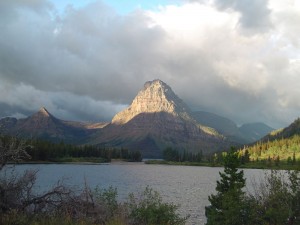 We kept in touch with Roch via cell phone, and picked him up at about 1:15. We then filled the car with gas headed East on US 2 into Glacier National Park at the West Glacier entrance. Determining that we wanted to camp on the east side of the park, and after discussing the situation with a Ranger, we decided not to take “Going to the Sun Road” across the park since the clouds were low and it was raining. Instead, we took US 2 around the south end of the park to the East Glacier entrance. Although it was still raining, we drove to Two Medicine Campground and pitched our tents. Using the Interagency pass I had purchased at Bryce the previous December, not only was our entrance fee paid for (as it was at Grand Teton and Yellowstone the day before), but a $20/night campsite was only $10 when you put your pass number on the payment slip. Bob started getting the tents up while Roch and I walked back to the ranger station to reserve our camp site and get some hiking maps. At a clearing, two big horn sheep came right out in front of us for what would turn out to be the closest wildlife encounter of our stay. Fortunately, I had my camera with me.
We kept in touch with Roch via cell phone, and picked him up at about 1:15. We then filled the car with gas headed East on US 2 into Glacier National Park at the West Glacier entrance. Determining that we wanted to camp on the east side of the park, and after discussing the situation with a Ranger, we decided not to take “Going to the Sun Road” across the park since the clouds were low and it was raining. Instead, we took US 2 around the south end of the park to the East Glacier entrance. Although it was still raining, we drove to Two Medicine Campground and pitched our tents. Using the Interagency pass I had purchased at Bryce the previous December, not only was our entrance fee paid for (as it was at Grand Teton and Yellowstone the day before), but a $20/night campsite was only $10 when you put your pass number on the payment slip. Bob started getting the tents up while Roch and I walked back to the ranger station to reserve our camp site and get some hiking maps. At a clearing, two big horn sheep came right out in front of us for what would turn out to be the closest wildlife encounter of our stay. Fortunately, I had my camera with me.
After the campsite was set up, we proceeded to the shore of Two Medicine Lake and then hiked along the base of Rising Wolf Mountain heading toward Twin Falls. Some folks we met along the trail said that they had seen a black bear, but we didn’t see it. We did see a lot of cascades and very nice Alpine scenery. After 40 minutes we turned back, since it was still raining a bit and we were getting wet. For dinner that night we stopped at one of the places that line East Glacier Village. Especially good was the Huckleberry Pie. Huckleberries taste like a cross between blueberries and raspberries, and they grow wild along the trails in the park.
The main attraction at East Glacier is the Glacier Park Lodge, built by the Great Northern Railroad between 1913 and 1915. Glacier became a National Park in 1910, and was celebrating its 100th anniversary. This particular weekend tents (like for a wedding reception) had been placed on the grounds of the lodge, and we found out that former drivers of the red buses (called Red Cars) were being honored. The drivers are affectionately known as “Gear Jammers.” The red cars currently being used in the park are the 1934-37 White buses with removable canvass tops that had served the park for 60 years. These were removed from service in 1999 due to structural cracks. The Red Cars were refurbished (at no charge) by the Ford Motor Company and equipped with propane-fueled engines. The lodge has columns of 53-foot pine trunks in its great hall along with a massive fire place that three still-damp hikers appreciated greatly. It is a sight to see. Back at camp I found that sleeping in a tent for the first time in over 30 years took some getting used to.
 Friday, we took the trail that starts at the historic Two Medicine Camp Store to Cobalt Lake. The six mile trek (each way) went past Rockwell Falls and a Falls with no name, as well as past many cascades. We did see a female moose at a marsh. My camera could not zoom in close enough to get a good shot, but Roch’s did. Unfortunately, it started raining while we were on a part of the trail that emerged from tree cover, and we got both wet and muddy. Cobalt Lake itself is located in an amphitheater, and has a vestigial patch of glacier-like snow just above its shore. The lake has a green color that hints that glacial run off sustains it. We met up with one of the former Red Car drivers at the lake shore. He was from Eden Prairie, MN, so I had to tell him that I had been in Mounds View a few weeks before. He gave us some good advice about hikes we would take when we moved our camp to the Many Glacier campground on Sunday. Since we were still wet, we started getting cold as we sat eating lunch by the lake, so it was time to head back. Even though the rain had virtually stopped, the vegetation along the trail was still wet so our pants and boots continued to collect water. Finally, we reached the historic Two Medicine Camp store and went inside for some hot chocolate. Why would this camp store be historic? It was built by the Great Northern Railroad as the Two Medicine Chalet to accommodate visitors who had ridden into the park on horseback. But the building became historic in August 1934 when Franklin Roosevelt delivered one of his fireside chats from the building, and stayed at the chalet. And the fireside at the camp store was enjoyed by three rather damp hikers that afternoon. That night we returned to East Glacier Village for dinner. The Mexican restraunt had been recommended, but even out of season it had a line running outside the building. So, we settled on the diner next to it. Before entering, Amtrak’s “The Empire Builder” (the train named for the Great Northern Railroad’s founder) pulled into East Glacier station. It stayed for about 20 minutes before pulling out, and the locals said it was only 12 minutes late. The diner’s food was very good. Our server was a student from Ukraine. The staff is seasonal at all the establishments surrounding the park. The rain stopped as night fell, and you could see what seemed to be every star in the sky from our camp site. As the skies cleared, the wind started blowing and the temperatures dropped. That night, the wind roared. But the sleeping bags were warm, and I slept better than I had the first night.
Friday, we took the trail that starts at the historic Two Medicine Camp Store to Cobalt Lake. The six mile trek (each way) went past Rockwell Falls and a Falls with no name, as well as past many cascades. We did see a female moose at a marsh. My camera could not zoom in close enough to get a good shot, but Roch’s did. Unfortunately, it started raining while we were on a part of the trail that emerged from tree cover, and we got both wet and muddy. Cobalt Lake itself is located in an amphitheater, and has a vestigial patch of glacier-like snow just above its shore. The lake has a green color that hints that glacial run off sustains it. We met up with one of the former Red Car drivers at the lake shore. He was from Eden Prairie, MN, so I had to tell him that I had been in Mounds View a few weeks before. He gave us some good advice about hikes we would take when we moved our camp to the Many Glacier campground on Sunday. Since we were still wet, we started getting cold as we sat eating lunch by the lake, so it was time to head back. Even though the rain had virtually stopped, the vegetation along the trail was still wet so our pants and boots continued to collect water. Finally, we reached the historic Two Medicine Camp store and went inside for some hot chocolate. Why would this camp store be historic? It was built by the Great Northern Railroad as the Two Medicine Chalet to accommodate visitors who had ridden into the park on horseback. But the building became historic in August 1934 when Franklin Roosevelt delivered one of his fireside chats from the building, and stayed at the chalet. And the fireside at the camp store was enjoyed by three rather damp hikers that afternoon. That night we returned to East Glacier Village for dinner. The Mexican restraunt had been recommended, but even out of season it had a line running outside the building. So, we settled on the diner next to it. Before entering, Amtrak’s “The Empire Builder” (the train named for the Great Northern Railroad’s founder) pulled into East Glacier station. It stayed for about 20 minutes before pulling out, and the locals said it was only 12 minutes late. The diner’s food was very good. Our server was a student from Ukraine. The staff is seasonal at all the establishments surrounding the park. The rain stopped as night fell, and you could see what seemed to be every star in the sky from our camp site. As the skies cleared, the wind started blowing and the temperatures dropped. That night, the wind roared. But the sleeping bags were warm, and I slept better than I had the first night.
Saturday, we dismantled camp and headed to the town of St. Mary and the eastern end of Going to the Sun Road. We ate breakfast at the Park Inn Cafe, which was very good, and secured our accommodations at the Red Eagle Motel. We got the Wind Rose Cabin, which was really a trailer, but it had 3 beds, satellite TV, a kitchen, and a full-sized washer and dryer, for only $150 for the night! After dropping off our stuff and getting some provisions from the supermarket in St. Mary to pack our lunches, we headed up Going to the Sun Road to Logan Pass visitor center. From the Visitor Center we hiked to Hidden Lake (3 miles out, 3 miles back). Hidden Lake is absolutely beautiful, surrounded by peaks. The trail leading down to the lake is rather steep, so not many folks hike all the way down. This made our lunch at the lake shore all the more peaceful. I really didn’t want to leave, but the time came. The climb out was tough, but seeing that lake from its shore was well worth it. Back at the “cabin” we showered, washed and dried clothes and rested. It felt wonderful to be warm and dry. For dinner, we ended up going to the Cattlemen’s Supper Club on US 89 in Babb, MT, just 10 miles from the Canadian Border. I ordered a rare filet, and it came really rare. The first time I have ever encountered that. If you really like your steak rare, this is the place for you.
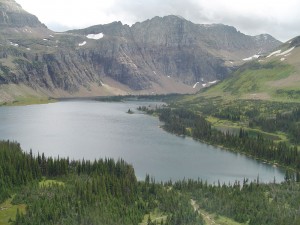 Next morning we packed the car, had breakfast at the Park Inn again (there was a line this time), and then headed back to Babb and the Many Glacier entrance to the park. Along the road leading to the entrance, we stopped to take pictures of Sherburne Lake. At the entrance we got a boat schedule and found that the next boat trips across Swift Current Lake and Lake Josephine were departing at 11 am. We had 45 minutes to get our camp site and get our tickets for the boat trips to start our hike to Grinnell Glacier. Taking the boats both ways enables hikers to cut a total of 5 miles off the hike. We managed with a few minutes to spare as I dropped Bob and Roch off at the Many Glacier Lodge (also built by the Great Northern) and parked the car while they bought the boat tickets. Interesting stories told by the boat pilots about the great fire of 1936 (the rail road asked why heroic measures were taken to save the lodge), and mining interests (the US Government bought the east part of Glacier from the Blackfoot Nation not for park use but so that mining interests could exploit resources that turned out not to be there). The hike to Grinnell Glacier would be seven plus miles round trip, but the worst part is that you gain 1440 feet in elevation on the trail, with much of the elevation gain coming on the final quarter mile. Along the way you see Salamander Glacier, Gem Glacier (the smallest glacier in the park and the only one that has been growing lately) and Grinnell Glacier, you see Grinnell Lake, which is fed by the three glaciers and is very beautiful, along with Grinnell Falls (the cascade of the run off from the three glaciers). We saw Mountain Goats on the hillsides above us, but they were too far away for pictures. About 1/4 mile from Grinnell Glacier there is a clearing where benches have been placed along with a pit toilet and a marker describing Grinnell Glacier and George Bird Grinnell’s discovery of it. This is a very unfortunately location for the rest area because it gives the impression that the hard part of the hike is over when in reality the hardest part of the hike lies ahead. But persevere and you will be rewarded with the site of Upper Grinnell Lake, with Grinnell Glacier surrounding it and Salamander Glacier above. You can hike onto Grinnell Glacier itself, my first encounter with a glacier. The lake has the milky green color caused by microbes from the glacial ice. The glacial ice itself has that same blue-green hue as you see in films of glaciers at Glacier Bay Alaska. Bob asked a Ranger who was leading a hike down from the Grinnell Glacier if there was going to be a “Ranger Talk” that night, and she said yes, at 8 pm at the Many Glacier Lodge. We ate lunch, answered some questions from some Sun Valley, ID 8th graders there on a field trip (they were measuring the depth of the glacial lake and asking folks about climate change), and then headed back down the trail. When we got to Lake Josephine there was an hour before the next boat was scheduled to arrive, so we hiked the trail we had skipped on the way up. At Swift Current Lake, Bob headed back to the camp site while Roch and I hiked the remaining 2.5 miles to get to the Lodge and the car. Back at camp we changed quickly and then headed out to US 89 to Two Sisters Near Babb (TSNB for short), a really fun road house restaurant. The place has license plates from everywhere hanging on the walls and serves great sweet potato Fries! This was probably our best meal of the trip. We got back to the lodge just as the Ranger Talk was beginning. I parked the car and joined the group during the presentation, which was a very informative history of the park and its competing mandates of being a place for people to visit while at the same time trying to preserve and protect its natural beauty. The Ranger mentioned that unlike at Yellowstone, wolves had been repopulating Glacier by wandering into the park rather than being re-introduced by humans. I think I heard some wolves howling later that night while we were in our camp site. The talk was very informative, with slides, and following the talk we poked around the Many Glacier Lodge for a bit. I didn’t sleep well that night although conditions were the best for tent sleeping that we would encounter. I could not get my head in a comfortable position.
Next morning we packed the car, had breakfast at the Park Inn again (there was a line this time), and then headed back to Babb and the Many Glacier entrance to the park. Along the road leading to the entrance, we stopped to take pictures of Sherburne Lake. At the entrance we got a boat schedule and found that the next boat trips across Swift Current Lake and Lake Josephine were departing at 11 am. We had 45 minutes to get our camp site and get our tickets for the boat trips to start our hike to Grinnell Glacier. Taking the boats both ways enables hikers to cut a total of 5 miles off the hike. We managed with a few minutes to spare as I dropped Bob and Roch off at the Many Glacier Lodge (also built by the Great Northern) and parked the car while they bought the boat tickets. Interesting stories told by the boat pilots about the great fire of 1936 (the rail road asked why heroic measures were taken to save the lodge), and mining interests (the US Government bought the east part of Glacier from the Blackfoot Nation not for park use but so that mining interests could exploit resources that turned out not to be there). The hike to Grinnell Glacier would be seven plus miles round trip, but the worst part is that you gain 1440 feet in elevation on the trail, with much of the elevation gain coming on the final quarter mile. Along the way you see Salamander Glacier, Gem Glacier (the smallest glacier in the park and the only one that has been growing lately) and Grinnell Glacier, you see Grinnell Lake, which is fed by the three glaciers and is very beautiful, along with Grinnell Falls (the cascade of the run off from the three glaciers). We saw Mountain Goats on the hillsides above us, but they were too far away for pictures. About 1/4 mile from Grinnell Glacier there is a clearing where benches have been placed along with a pit toilet and a marker describing Grinnell Glacier and George Bird Grinnell’s discovery of it. This is a very unfortunately location for the rest area because it gives the impression that the hard part of the hike is over when in reality the hardest part of the hike lies ahead. But persevere and you will be rewarded with the site of Upper Grinnell Lake, with Grinnell Glacier surrounding it and Salamander Glacier above. You can hike onto Grinnell Glacier itself, my first encounter with a glacier. The lake has the milky green color caused by microbes from the glacial ice. The glacial ice itself has that same blue-green hue as you see in films of glaciers at Glacier Bay Alaska. Bob asked a Ranger who was leading a hike down from the Grinnell Glacier if there was going to be a “Ranger Talk” that night, and she said yes, at 8 pm at the Many Glacier Lodge. We ate lunch, answered some questions from some Sun Valley, ID 8th graders there on a field trip (they were measuring the depth of the glacial lake and asking folks about climate change), and then headed back down the trail. When we got to Lake Josephine there was an hour before the next boat was scheduled to arrive, so we hiked the trail we had skipped on the way up. At Swift Current Lake, Bob headed back to the camp site while Roch and I hiked the remaining 2.5 miles to get to the Lodge and the car. Back at camp we changed quickly and then headed out to US 89 to Two Sisters Near Babb (TSNB for short), a really fun road house restaurant. The place has license plates from everywhere hanging on the walls and serves great sweet potato Fries! This was probably our best meal of the trip. We got back to the lodge just as the Ranger Talk was beginning. I parked the car and joined the group during the presentation, which was a very informative history of the park and its competing mandates of being a place for people to visit while at the same time trying to preserve and protect its natural beauty. The Ranger mentioned that unlike at Yellowstone, wolves had been repopulating Glacier by wandering into the park rather than being re-introduced by humans. I think I heard some wolves howling later that night while we were in our camp site. The talk was very informative, with slides, and following the talk we poked around the Many Glacier Lodge for a bit. I didn’t sleep well that night although conditions were the best for tent sleeping that we would encounter. I could not get my head in a comfortable position.
In the morning we broke camp and headed back to St. Mary. We ate breakfast at Johnson’s up the hill from the Park Inn. Johnson’s has a better breakfast and no lines! Then it was back to the Logan Pass Visitor Center for our final hike of the trip. As we were stopped at the road construction just below the pass, emergency vehicles started coming up the road and an evac helicopter flew around the road. Eventually our line of traffic went forward, and when we parked at the Visitor Center, the evac helicopter was in the parking lot. We learned later that a worker’s Bobcat had tumbled down an embankment, and the worker had gotten out after about 100 feet while the Bobcat fell another 100 feet. The helicopter eventually took the worker to a hospital in Kalispel.
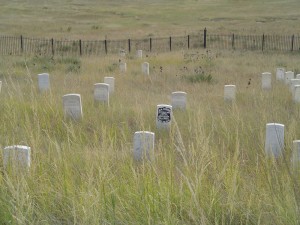 From Logan Pass we hiked past the Continental Divide along the Highline Trail (a suggestion from the former Red Car driver we met at Cobalt Lake) 7.6 miles to Granite Park Chalet (built by the Great Northern). As we hiked along the formation known as the Garden Wall, we were actually only separated from Grinnell Glacier by that formation. After hiking over a great elevation the day before, we chose this trail because it only entailed an 800 foot gain in elevation over the 7.6 miles. We encountered some Mule Deer on the trail who were really not afraid of humans at all. I had to shoo them off the trail. We saw magnificent peaks, and Lake McDonald off in the distance. The Chalet had its final visitors of the season the previous Thursday, and we encountered some of the Chalet workers on the trail who had been closing the place up (no roads lead to the chalet). When we got to the chalet, the only benches were occupied by fellow hikers, as was the one picnic table that wasn’t in an area that was taped off. So, we proceeded to the tables in the taped off area, but were shooed out of there by a Ranger we hadn’t seen before. The couple at the table that wasn’t off limits asked if we wanted to join them so we did. They were from Hawaii, and they had hiked from Logan Pass and were going to hike the 7.6 miles back to their car. Our plan was for Bob to take off immediately after lunch and hike the 4 miles down from the Chalet to the parking area on Going to the Sun Road where he would hitch a ride back to Logan Pass Visitor Center and our car. The shuttles that would take you back stop running at Labor Day, but hitching is supposedly a common practice in the park. After giving Bob a head start, Roch and I would hike down the hill and meet Bob when he drove up. After Bob left, Mr. Hawaiian Couple said that he was a maritime lawyer. Since both Roch and I had worked for the Civil Division of the U.S. Department of Justice, we said that he must have encountered some of our San Francisco office admiralty attorneys. He knew the present and former Attorneys-in-Charge quite well, and stories about some of the more memorable characters were traded until it was time to go. Roch and I went down the hill and kept a good 24 minutes to the mile pace. It had become sunny and warm, and I was overdressed for the trek, but 90 minutes later we were at the parking area. A thermometer on the rest room exterior said that it was 72 degrees! Bob eventually arrived, and we departed. Bob had had some trouble hitching a ride, but finally some latter day hippies traveling through the park on their way back from Alaska had picked him up. He gave them $20 for gas to help with their future travels. I was driving now, and as we headed west on Going to the Sun, we saw how beautiful Lake McDonald looked from shore level. I wanted to get some tee shirts before leaving the park, so we went to West Glacier Village to get shirts and ice cream. Then we sat by the very placid lake in the late afternoon and looked back at the Garden Wall and the trail we had just taken off in the distance just as we had looked at Lake McDonald from that trail. I didn’t want to leave a setting so tranquil.
From Logan Pass we hiked past the Continental Divide along the Highline Trail (a suggestion from the former Red Car driver we met at Cobalt Lake) 7.6 miles to Granite Park Chalet (built by the Great Northern). As we hiked along the formation known as the Garden Wall, we were actually only separated from Grinnell Glacier by that formation. After hiking over a great elevation the day before, we chose this trail because it only entailed an 800 foot gain in elevation over the 7.6 miles. We encountered some Mule Deer on the trail who were really not afraid of humans at all. I had to shoo them off the trail. We saw magnificent peaks, and Lake McDonald off in the distance. The Chalet had its final visitors of the season the previous Thursday, and we encountered some of the Chalet workers on the trail who had been closing the place up (no roads lead to the chalet). When we got to the chalet, the only benches were occupied by fellow hikers, as was the one picnic table that wasn’t in an area that was taped off. So, we proceeded to the tables in the taped off area, but were shooed out of there by a Ranger we hadn’t seen before. The couple at the table that wasn’t off limits asked if we wanted to join them so we did. They were from Hawaii, and they had hiked from Logan Pass and were going to hike the 7.6 miles back to their car. Our plan was for Bob to take off immediately after lunch and hike the 4 miles down from the Chalet to the parking area on Going to the Sun Road where he would hitch a ride back to Logan Pass Visitor Center and our car. The shuttles that would take you back stop running at Labor Day, but hitching is supposedly a common practice in the park. After giving Bob a head start, Roch and I would hike down the hill and meet Bob when he drove up. After Bob left, Mr. Hawaiian Couple said that he was a maritime lawyer. Since both Roch and I had worked for the Civil Division of the U.S. Department of Justice, we said that he must have encountered some of our San Francisco office admiralty attorneys. He knew the present and former Attorneys-in-Charge quite well, and stories about some of the more memorable characters were traded until it was time to go. Roch and I went down the hill and kept a good 24 minutes to the mile pace. It had become sunny and warm, and I was overdressed for the trek, but 90 minutes later we were at the parking area. A thermometer on the rest room exterior said that it was 72 degrees! Bob eventually arrived, and we departed. Bob had had some trouble hitching a ride, but finally some latter day hippies traveling through the park on their way back from Alaska had picked him up. He gave them $20 for gas to help with their future travels. I was driving now, and as we headed west on Going to the Sun, we saw how beautiful Lake McDonald looked from shore level. I wanted to get some tee shirts before leaving the park, so we went to West Glacier Village to get shirts and ice cream. Then we sat by the very placid lake in the late afternoon and looked back at the Garden Wall and the trail we had just taken off in the distance just as we had looked at Lake McDonald from that trail. I didn’t want to leave a setting so tranquil.
But, schedules prevailed, and we headed back onto US 2 and west toward Kalispel. We wanted to stay at the Glacier Gateway motel in Columbia Falls (between the park and Kalispel airport) but didn’t see it and we drove past the airport all the way into Kalispel until we got to a LaQuinta Inn, the first lodging we had seen. The LaQuinta was full. Why would a place in Kalispel, MT be full on a Monday night a full week after Labor Day? The desk said that they had called around and the only places with vacancies were on US 93 south of town, even further away from the airport. Roch’s flight was leaving the next morning at 7:10, so this wasn’t going to work. We called the number for the Glacier Gateway Motel and found that we had missed it, and that there were vacancies. When we finally arrived, we saw that it was just called the Glacier Motel, but so be it. The manager was a young man who was legally blind due to botched surgery to repair detached retinas. He told us to go to Backroom Ribs for dinner, which was just a few stop lights down US 2. It was a great suggestion. I ordered off the senior menu (55 and over – my first senior order – I was very disappointed that I was not challenged). The food was great.
Then it was up early the next morning, out at 5:45, dropping Roch off by 6 am, and then we hit the road for the 1,000 miles to Boulder, CO. Looking at the map, I noticed that Little Big Horn was just off I-90 in Montana. I had always thought that Little Big Horn was in South Dakota. I told Bob that we had to stop, and when we stopped at the Douglas County, MT Visitors Center to get Montana road maps, the lady at the desk assured us that the monument was just off the interstate. When we arrived a ranger was giving his talk and he was comparing Crazy Horse and Custer as leaders. His talk was very informative and afterward when we walked up the hill to the headstones, as you looked over the prairie you could see how the skirmishes and battle unfolded just as the Ranger had described them. I was so glad we stopped.
Then it was on into Wyoming and eventually Colorado, and then to Boulder (arriving at 10:30 pm) where I was a guest at Bob’s house for the night.
I flew back the next afternoon. On the flight from Denver to Minneapolis I sat next to a retired teacher from Travers City, MI. She had gotten married in her 40s, and she and her husband have an RV and travel extensively. This was her return from a trip visiting a girlfriend in Estes Park, CO. I don’t usually talk to folks on airplanes, but we talked for the entire trip. Although my flight went on to DCA, because there was a crew change I had to get off the plane. I walked around the terminal for a few minutes and then it was time to get back on the plane and fly home.
I had the time of my life on a journey that combined a grand road trip along with camping and hiking. The people in the northern plains and northwest all seem to be very friendly. I saw some marvelous sights and went places I never dreamed I go. I didn’t like the weather around Glacier, but there are still lots of sights there for me to see, so I know that I will be back. I also got to reconnect with one of my best friends. And I found that discovering things with two of my friends was a great experience for me, and hopefully for us all.
Please share the story on Facebook, or donate to support our efforts!


















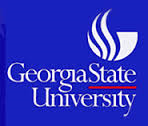



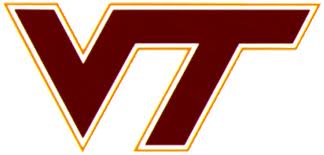







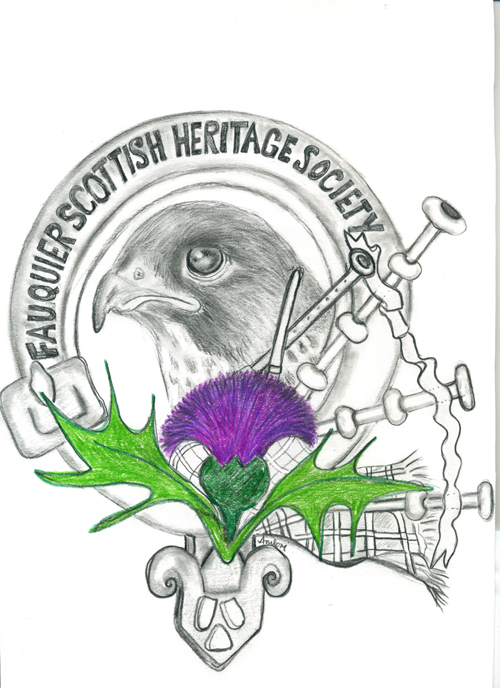
.jpg)

























